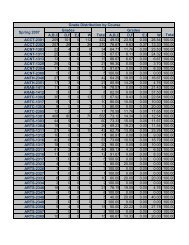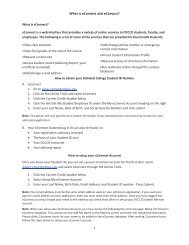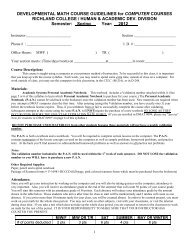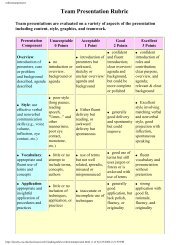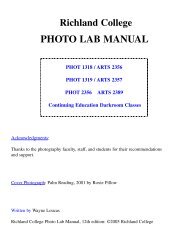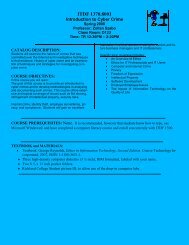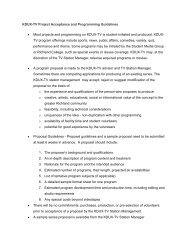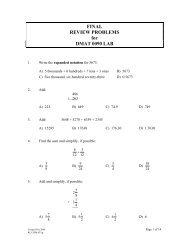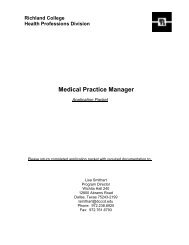End of Year Report - Richland College
End of Year Report - Richland College
End of Year Report - Richland College
Create successful ePaper yourself
Turn your PDF publications into a flip-book with our unique Google optimized e-Paper software.
Strategic Planning Priority Goal #1: Identify and Meet Community Educational Need<br />
18<br />
<strong>Richland</strong> <strong>College</strong><br />
Strategic Planning Priority Goal #1:<br />
Identify and Meet Community Educational Needs<br />
Score = 9.5<br />
Introduction<br />
<strong>Richland</strong>’s leadership tracks 4 key performance indicators with 1 operational* and 17 strategic*<br />
measures to determine how well the college identifies and meets our community’s educational needs.<br />
The four areas <strong>of</strong> focus include building sustainable community relationships through dual credit<br />
arrangements with service area high schools, participation <strong>of</strong> students in service learning projects,<br />
and faculty and staff donations to the State Employee Charitable Campaign (SECC). <strong>Richland</strong> regularly<br />
communicates with community stakeholders through outreach to service area high schools and<br />
various community organizations. Although the college does not conduct outreach activities outside<br />
the defined service area, <strong>Richland</strong> serves and communicates with all the residents <strong>of</strong> Dallas County<br />
and outside Dallas County on a limited basis. <strong>Richland</strong> is dedicated to increasing market share for<br />
key student segments. This group includes African-American and Hispanic students, economically<br />
disadvantaged students, and non-high school graduates. <strong>Richland</strong> provides business and industry<br />
workforce training through our technical-occupational <strong>of</strong>ferings and our Garland Campus dedicated to<br />
workforce training. Finally <strong>Richland</strong> responds to the community’s diverse educational needs through<br />
a variety <strong>of</strong> course types and delivery options. These include: face-to-face instruction; online instruction;<br />
courses that range from 4 to 16 weeks in duration; courses that prepare students for transfer to a<br />
university; developmental courses that prepare students for college-level work and to communicate in<br />
the English language. In a cycle <strong>of</strong> improvement this year, <strong>Richland</strong> eliminated the previous 2009-10<br />
KPIs 1.2 and 1.3 and created a new KPI 1.2 with a focus on increasing the market share <strong>of</strong> key student<br />
segments. This new KPI incorporated all the measures from the previous 2 KPIs and relocated a<br />
dual credit measure for a total <strong>of</strong> 9 measures under the newly created KPI 1.2 Increase market share<br />
<strong>of</strong> key student segments. Following is a summary <strong>of</strong> <strong>Richland</strong>’s performance on 4 KPIs for Identifying<br />
and Meeting Community Educational Needs.<br />
Organizational Objectives/KPIs Performance Summary<br />
1.1 Score = 9.15<br />
Initiate Relationships for Sustainable Community Building reflects a score within the range<br />
<strong>of</strong> tolerance although the score is a decrease <strong>of</strong> 0.32 compared to 2009-10. One strategic* measure<br />
exceeds the target range and 1 operational* measure falls below the target range. This KPI<br />
aligns with the college’s core competency <strong>of</strong> sustainable community building and the strategic<br />
advantages <strong>of</strong> an excellent reputation in the community we serve and strong community relationships.<br />
*Strategic measures are those identified for special emphasis by college leadership, the DCCCD Board <strong>of</strong> Trustees, the state or national government, or<br />
SACS accreditation agency. Operational measures are those key to the ongoing vitality <strong>of</strong> the organization but without strategic emphasis.<br />
<strong>End</strong> <strong>of</strong> <strong>Year</strong> <strong>Report</strong> 2010-11



